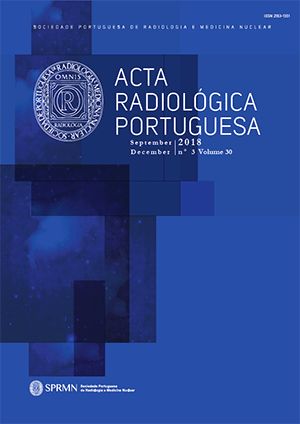Unusual Skull Base Lesion: Hemangiopericytoma of the Middle Cranial Fossa
DOI:
https://doi.org/10.25748/arp.14813Abstract
Meningioma is the most common intracranial tumor affecting the skull base and the diagnosis is usually straightforward on imaging studies. However, other lesions can appear similar on imaging studies.
A 60 year-old-man presented with non-specific neurological symptoms, including memory loss and behavioral changes. CT and MR imaging disclosed an extra-axial, dural-based lesion in the middle cranial fossa. The lesion was remarkable for its hypervascular nature with strong and early contrast enhancement, large peripheral flow voids and vasogenic edema of the adjacent brain parenchyma.
Although the most common dural-based lesion of the CNS is the meningioma, radiologists should be aware of other differential diagnoses, particularly when facing atypical imaging features. These comprise metastases, lymphoma and leukemia, histiocytic lesions, sarcoidosis and hemangiopericytoma. These lesions have a significant impact on patient´s management. Based on imaging findings we were able to suggest the diagnosis of hemangiopericytoma and the patient was managed accordingly.O meningioma é o tumor intracraniano mais comum na base do crânio e o seu diagnóstico imagiológico é habitualmente claro, mas outras lesões podem apresentar-se com achados semelhantes.
Um homem de 60 anos apresentou-se com perda de memória e alterações comportamentais. Efectuou Tomografia Computorizada (TC) e Ressonância Magnética (RM) de crânio que demonstraram uma lesão extra-axial de base dural na fossa média. A lesão possuía forte realce com natureza hipervascular, vasos periféricos e edema vasogénico do parênquima cerebral adjacente.
Embora a lesão de base dural mais comum do sistema nervoso central (SNC) seja o meningioma, devem-se considerar outros diagnósticos diferenciais, particularmente na presença de características de imagem atípicas. Nestes incluem-se metástases, linfoma e leucemia, lesões histiocíticas, sarcoidose e hemangiopericitoma. Com base nos achados de imagem, sugerimos o diagnóstico de hemangiopericitoma e o doente foi sujeito a cirurgia de ressecção tumoral e radioterapia adjuvante, encontrando-se um pequeno resíduo tumoral estável nos estudos de seguimento.
Downloads
Published
Issue
Section
License
CC BY-NC 4.0


